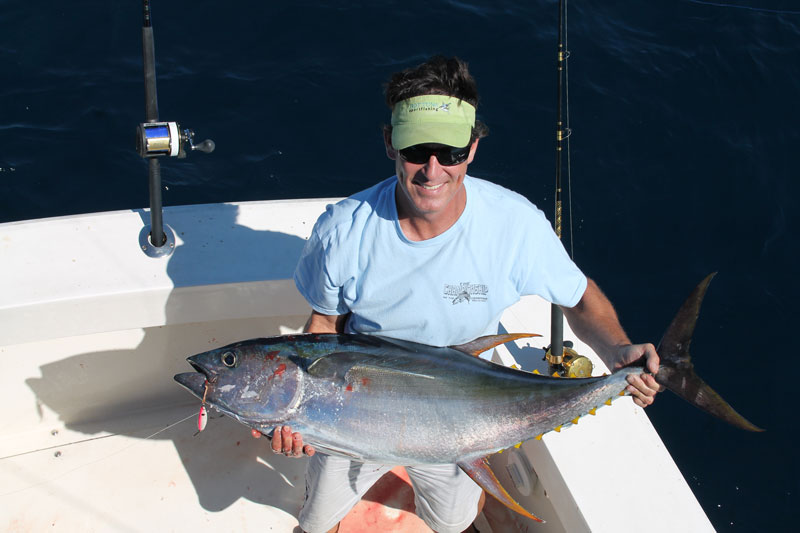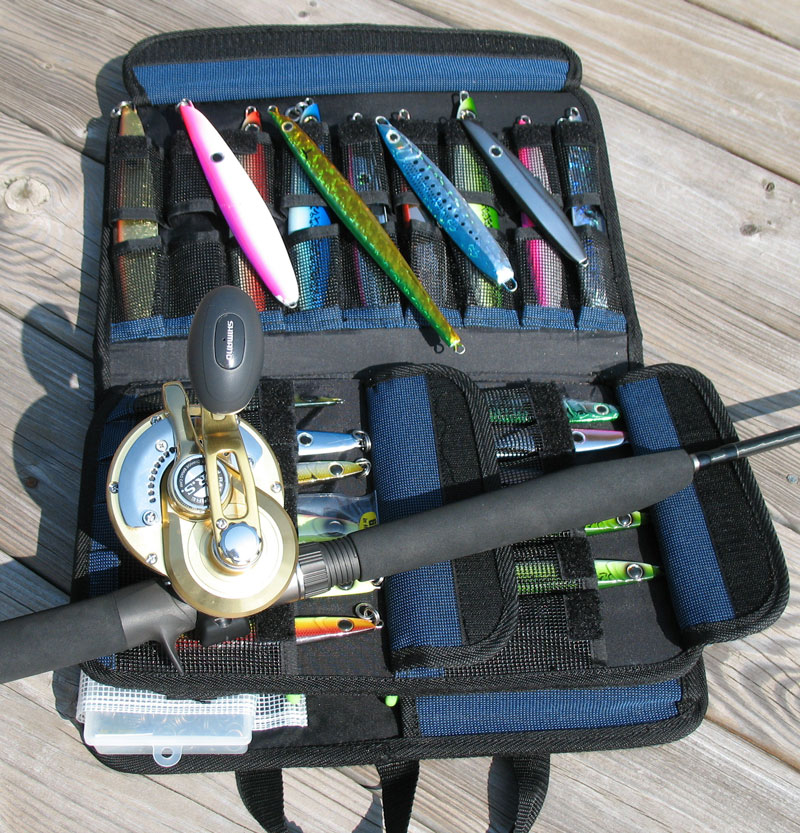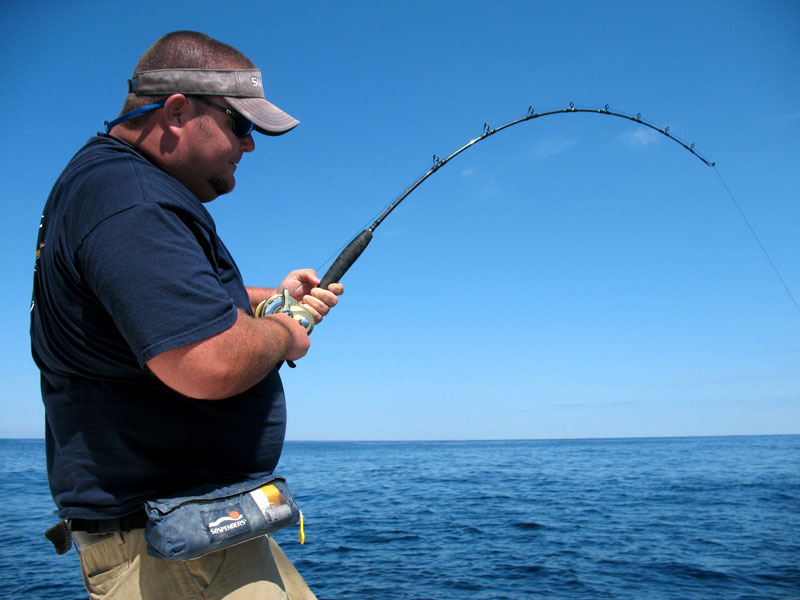We hope you trollers saw Yellowfin Tuna Fishing Tactics Part One: Trolling, and that chunkers have seen Yellowfin Tuna Fishing Tactics Part Two: Chunking. Now, let's check out jigging for tuna. Jigging is not some newfangled fad. I can recall diamond jigs in my father’s tackle box back in the 60s. But for some reason, at least when it comes to offshore fishermen just got away from the technique of jigging. However, the tactic really got a shot in the arm when Shimano developed a line of butterfly jigs in the 90s to reach deep bluefin. Now, the jig’s popularity is once again growing with its reintroduction to tuna anglers.

Cranking and Jigging
Jigging can be performed with any type of outfit. However, the best results are obtained with a reel that’s capable of retrieving line at a high rate of speed and a lightweight rod that does not wear the arms out. Braid line is preferred with a 20-foot wind-on fluoro leader, since braided line allows the jig to sink quickly, does not cause line drag like mono, and the absence of stretch allows immediate hookups.
Working the jig through depths where tuna are suspended is the trick. When fish show up on the sonar, drop the jig below them and work it up through the water column. The process is repeated until hooking up. Blindly dropping to the bottom and working to the surface over and over will wear out any angler. This may work, but not for long! To maximize the return for your effort, mark your line at 50-, 100-, 150- and 200-foot intervals. Permanent markers work on braided line, but a piece of wax rigging line tied to the mainline lets the angler quickly see depth marks and easily runs in and out through the rod guides. If fish are being read at 120 feet on the sonar, the jig can be quickly dropped to the 150 mark and worked up to 100. No strikes? The jig is already at 100 feet, so just drop back to 150. This way the jig spends the maximum amount of time in prime water and you don’t wear yourself out with unnecessary cranking.
A word of caution: hold the rod tightly. The savage attack that often comes on the moving jig can and will result in the rod being jerked out of your hand if you’re not careful. This was illustrated in great clarity one day while jigging. I heard a big splash behind me on other side of cockpit and turned around, only to see my brother-in-law under water. His quick reaction and diving overboard saved one of my jigging outfits, after it was jerked out of his hand. I’m glad to report the rod and brother-in-law both survived the incident – although the tuna was lost!
Jigging is an ideal tactic to employ while chunking for tuna. Chunk lines will be behind the boat, which allows a couple members of the crew to take turns jigging. Also keep those jigging outfits ready while trolling. You’re marking tuna deep, but they refuse to rise and take trolled baits? Wind in the spread and send some jigs down to their depth. It just could be the ticket to making an empty fish box look good.
The technique for jigging consists of quickly sweeping the rod skyward and retrieving line as the rod is lowered before repeating the action. The method duplicates the erratic movement of baitfish fleeing towards the surface. But be prepared, often the jig is attacked as it falls due to the attractive flutter. There are several manufacturers producing jigging tackle. I use Shimano and Daiwa gear which I’ve owned for years. The Daiwa Saltist 30H is a decent reel with a 6.1:1 gear ratio taking in 36-inches of line per crank. I teamed this reel with Shimano’s Trevala TFC-58H rod, which makes a decent jigging outfit for the price. The Saltist reels have a very smooth star drag system which do not allow for a strike position. When purchasing any jigging outfit stay away from level wind reels, they just don’t work with the rapid, constant action.

The Shimano System
Shimano has taken the most desired jigging features and developed the Butterfly system, which consist of their own line of jigs, rods and reels. I had the opportunity to spend a couple days on the Mid-Atlantic with Justin Poe (a Product Manager for Shimano at the time), testing out the Butterfly system.
Jigging may have been growing in popularity at the time, however, up to that point I had not invested precious offshore trolling or chunking time into jigging. At least, not until Justin demonstrated how jigs can catch just about everything with fins. It takes a few minutes to master the technique of swinging the rod upwards as one crank is taken on the reel. This results in about four feet of line recovered on each sweep and crank.

For jigs, remember that in this application the hook should be rigged to hang from the top of the jigging spoon, not the bottom. As you rip the jig up through the water column, water pressure holds the hook down near the middle of the jig. Also, don’t think you have to use a huge jig for a tuna to strike. Four or five ounce jigs are plenty large to attract the tuna’s attention, and heavier jigs will tire you out much faster.
I’ve used all types of manufacturer’s reels for offshore fishing, and the Shimano’s are among the smoothest reels I’ve had in my hands. They do not come cheap, but you may find as I have that the outfits do more than just jig. Years ago, I matched the Torsa 20 with a Trevala TVC-58XH as my jigging outfit – but it’s also a pitch bait and deep drop rod. Spooled with 50-pound braid and a wind-on leader, it handles trolling duties as well and the light weight is ideal for children or small adults who have difficulty handling a big 30- or 50-class outfit. And when I discover where my wife hid the checkbook, I’m going to decorate the cockpit with more just like it!
See Yellowfin Tuna Tactics Part I: Trolling
and
Yellowfin Tuna Tactics Part II: Chunking
For additional information on tuna tactics, pick up copies of my books “Offshore Pursuit” and “Saltwater Tales.” Lenny’s book “Modern Jigging” is another great read to learn jigging techniques.
- By John Unkart